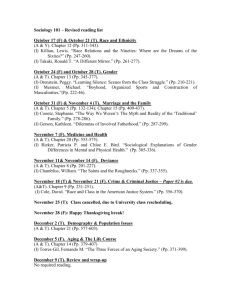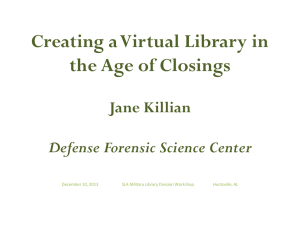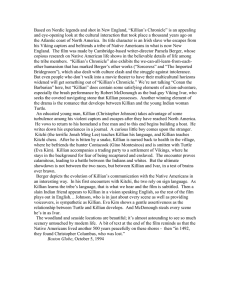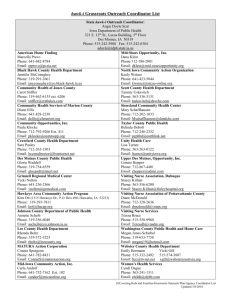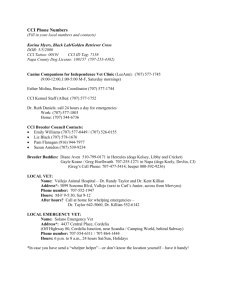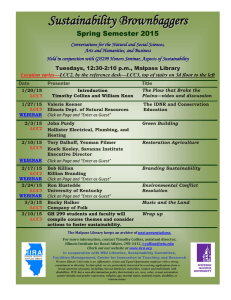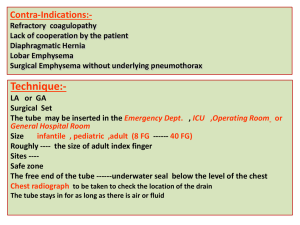Document 10430453
advertisement
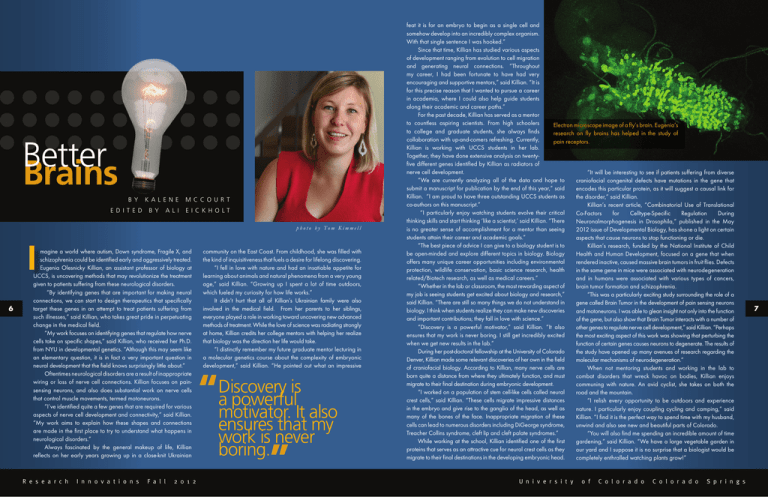
Better Brains B Y E D I T E D K A L E N E B Y A L I M C C O U R T E I C K H O LT photo by Tom Kimmell I 6 magine a world where autism, Down syndrome, Fragile X, and schizophrenia could be identified early and aggressively treated. Eugenia Olesnicky Killian, an assistant professor of biology at UCCS, is uncovering methods that may revolutionize the treatment given to patients suffering from these neurological disorders. “By identifying genes that are important for making neural connections, we can start to design therapeutics that specifically target these genes in an attempt to treat patients suffering from such illnesses,” said Killian, who takes great pride in perpetuating change in the medical field. “My work focuses on identifying genes that regulate how nerve cells take on specific shapes,” said Killian, who received her Ph.D. from NYU in developmental genetics. “Although this may seem like an elementary question, it is in fact a very important question in neural development that the field knows surprisingly little about.” Oftentimes neurological disorders are a result of inappropriate wiring or loss of nerve cell connections. Killian focuses on painsensing neurons, and also does substantial work on nerve cells that control muscle movements, termed motoneurons. “I’ve identified quite a few genes that are required for various aspects of nerve cell development and connectivity,” said Killian. “My work aims to explain how these shapes and connections are made in the first place to try to understand what happens in neurological disorders.” Always fascinated by the general makeup of life, Killian reflects on her early years growing up in a close-knit Ukrainian R e s e a r c h I n n o v a t i o n s F a l l 2 0 1 2 community on the East Coast. From childhood, she was filled with the kind of inquisitiveness that fuels a desire for lifelong discovering. “I fell in love with nature and had an insatiable appetite for learning about animals and natural phenomena from a very young age,” said Killian. “Growing up I spent a lot of time outdoors, which fueled my curiosity for how life works.” It didn’t hurt that all of Killian’s Ukrainian family were also involved in the medical field. From her parents to her siblings, everyone played a role in working toward uncovering new advanced methods of treatment. While the love of science was radiating strongly at home, Killian credits her college mentors with helping her realize that biology was the direction her life would take. “I distinctly remember my future graduate mentor lecturing in a molecular genetics course about the complexity of embryonic development,” said Killian. “He pointed out what an impressive “ Discovery is a powerful motivator. It also ensures that my work is never boring. ” feat it is for an embryo to begin as a single cell and somehow develop into an incredibly complex organism. With that single sentence I was hooked.” Since that time, Killian has studied various aspects of development ranging from evolution to cell migration and generating neural connections. “Throughout my career, I had been fortunate to have had very encouraging and supportive mentors,” said Killian. “It is for this precise reason that I wanted to pursue a career in academia, where I could also help guide students along their academic and career paths.” For the past decade, Killian has served as a mentor to countless aspiring scientists. From high schoolers Electron microscope image of a fly’s brain. Eugenia’s to college and graduate students, she always finds research on fly brains has helped in the study of collaboration with up-and-comers refreshing. Currently, pain receptors. Killian is working with UCCS students in her lab. Together, they have done extensive analysis on twentyfive different genes identified by Killian as radiators of nerve cell development. “It will be interesting to see if patients suffering from diverse “We are currently analyzing all of the data and hope to craniofacial congenital defects have mutations in the gene that submit a manuscript for publication by the end of this year,” said encodes this particular protein, as it will suggest a causal link for Killian. “I am proud to have three outstanding UCCS students as the disorder,” said Killian. co-authors on this manuscript.” Killian’s recent article, “Combinatorial Use of Translational “I particularly enjoy watching students evolve their critical Co-Factors for Celltype-Specific Regulation During thinking skills and start thinking ‘like a scientist,’ said Killian. “There Neuronalmorphogenesis in Drosophila,” published in the May is no greater sense of accomplishment for a mentor than seeing 2012 issue of Developmental Biology, has shone a light on certain students attain their career and academic goals.” aspects that cause neurons to stop functioning or die. “The best piece of advice I can give to a biology student is to Killian’s research, funded by the National Institute of Child be open-minded and explore different topics in biology. Biology Health and Human Development, focused on a gene that when offers many unique career opportunities including environmental rendered inactive, caused massive brain tumors in fruit flies. Defects protection, wildlife conservation, basic science research, health in the same gene in mice were associated with neurodegeneration related/Biotech research, as well as medical careers.” and in humans were associated with various types of cancers, “Whether in the lab or classroom, the most rewarding aspect of brain tumor formation and schizophrenia. my job is seeing students get excited about biology and research,” “This was a particularly exciting study surrounding the role of a said Killian. “There are still so many things we do not understand in gene called Brain Tumor in the development of pain sensing neurons biology. I think when students realize they can make new discoveries and motoneurons. I was able to glean insight not only into the function and important contributions; they fall in love with science.” of the gene, but also show that Brain Tumor interacts with a number of “Discovery is a powerful motivator,” said Killian. “It also other genes to regulate nerve cell development,” said Killian. “Perhaps ensures that my work is never boring. I still get incredibly excited the most exciting aspect of this work was showing that perturbing the when we get new results in the lab.” function of certain genes causes neurons to degenerate. The results of During her post-doctoral fellowship at the University of Colorado the study have opened up many avenues of research regarding the Denver, Killian made some relevant discoveries of her own in the field molecular mechanisms of neurodegeneration.” of craniofacial biology. According to Killian, many nerve cells are When not mentoring students and working in the lab to born quite a distance from where they ultimately function, and must combat disorders that wreck havoc on bodies, Killian enjoys migrate to their final destination during embryonic development. communing with nature. An avid cyclist, she takes on both the “I worked on a population of stem cell-like cells called neural road and the mountain. crest cells,” said Killian. “These cells migrate impressive distances “I relish every opportunity to be outdoors and experience in the embryo and give rise to the ganglia of the head, as well as nature. I particularly enjoy coupling cycling and camping,” said many of the bones of the face. Inappropriate migration of these Killian. “I find it is the perfect way to spend time with my husband, cells can lead to numerous disorders including DiGeorge syndrome, unwind and also see new and beautiful parts of Colorado. Treacher Collins syndrome, cleft lip and cleft palate syndromes.” “You will also find me spending an incredible amount of time While working at the school, Killian identified one of the first gardening,” said Killian. “We have a large vegetable garden in proteins that serves as an attractive cue for neural crest cells as they our yard and I suppose it is no surprise that a biologist would be migrate to their final destinations in the developing embryonic head. completely enthralled watching plants grow!” U n i v e r s i t y o f C o l o r a d o C o l o r a d o S p r i n g s 7

